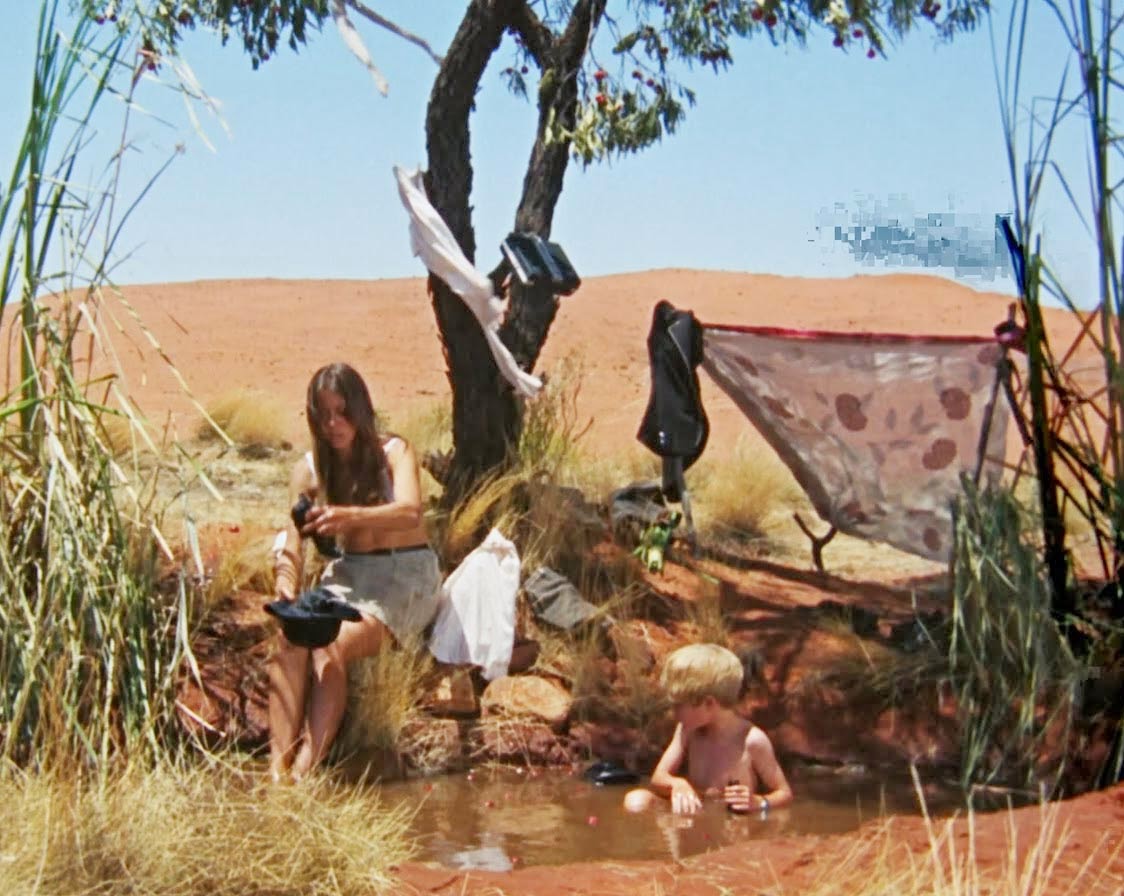Australia’s art cinema put it on the world map in the 1970s
Walkabout (1971), directed by Nicolas Roeg, was the first major movie to show the rest of the world what Australia was all about. It’s a well-known work for cineastes, but it wasn’t successful financially when first released. Many Australians didn’t like it because of how it critiques the ways in which the European civilized world attacks
the natural Australian continent insanely. Roeg’s status as an English director reinventing an English author’s novella about American children stranded in the outback resulted in an almost cold-eyed perspective. What he kept was the principal situation of two western children, specifically an English adolescent and her younger brother living in Adelaide, saved by an adolescent Aborigine in the midst of a ritualistic walkabout.
 |
| The Aborigine with the Young White Children |
The color photography by Roeg, both clear and iridescent, shows why so many ‘70s movies resound today: they look great. Roeg cuts the images in such a way that he draws parallels between the two cultures when the Aborigine slaughters a kangaroo for food and a butcher filets a chop. What mystifies and sickens the Aborigine is when he witnesses white hunters killing water buffaloes for the sport of it and leaving them to rot. The tragedy is that while the Aborigine and the young white boy develop a friendship, the adolescent white girl cannot communicate as openly because of the layers of psychosexual development separating her from him. However, at the beginning, her cool gutsiness outwits her berserk, homicidal father. In the final sequence, she recalls a sylvan idyll with the Aborigine and her younger brother, but we don’t know if it’s a memory or fantasy. David Gulpilil (also an extraordinary dancer), Jenny Agutter, and Luc Roeg act with an understated naturalness that complements the powerful imagery.
 |
| The Powerful Imagery in the Movie |
The final images constitute a motif that plays intermittently throughout the movie: brick walls and rock formations. The civilized world has come out of the natural one and the implication is that it may return to it. That’s one step beyond what Kubrick showed in
2001: A Space Odyssey. Roeg went on to make other disconcertingly edited yet intriguing movies, especially
Insignificance where four American pop culture stars interact over a twenty-four hour period in 1954 and manage to somehow explain the theory of Relativity, star in
The Seven Year Itch, envision a nuclear holocaust and its aftermath, and just plain hang out.
Australian Peter Weir used another novel for
Picnic at Hanging Rock (1975), a movie that my Mom really wanted to sneak me into when it was first released, but the cinema management stymied her. It was worth the almost forty year wait to see it. The story couldn’t be simpler: a girls’ school goes on a picnic to Hanging Rock on St. Valentine’s Day, 1900. When they arrive, the buggy operator notices his watch has stopped at noon.
 |
| The Girls Go Up to the Rock |
The girls nap in the afternoon shade, but four ask for permission to go up the rock. One comes screaming down later, a teacher goes up to look around, and neither she nor two of the girls are ever seen again. The behavior of the authoritarian headmistress is bizarre; she snobbishly bullies the girl with a major crush on Miranda, the leader of the disappeared. The rest of the girls behave hysterically, almost like predators, when one of the disappeared girls is found unconscious, but cannot remember anything.
 |
| Dexter Examines a Flower with Anne-Louise Lambert |
Cliff Green’s script is lean and subtle; there isn’t a wasted phrase in it. The acting is subtle, even Rachel Roberts as the creepy headmistress. Dominic Guard embodies idealistic decency, doomed to love the chimera of Miranda. It’s as if his earlier role as the eponymous
The Go-Between (1971) had transferred his puppy love for Julie Christie to Anne-Louise Lambert.
 |
| Hanging Rock |
What’s most remarkable is Russell Boyd’s cinematography; the color – the blues and yellows, especially – possesses the clarity and transparency of Monet. He also placed netting over the lens for the dream-like look of the picnic scenes. Max Lemon’s editing achieves a rhythm that feels like there’s an undertow to the plot. Weir concentrates on bird imagery, suggesting that the disappeared girls may have been transformed. However, the style of trekking through the rocks depends upon gender – the girls are shot from above and seem to be enveloped by the rocks, whereas the boys are shot from below and seem to be trying to surmount the phallic formations. The rocks themselves look like faces – a more eccentric version of the Easter Island sculptures – though they’re not man-made, and the movie insinuates that they may have consumed the girls.
Both suggestive and mesmerizing without fully explaining itself, Picnic at Hanging Rock has the force of art. Weir has been an excellent director of actors: Mel Gibson seemed like an Australian Steve McQueen in Gallipoli, but the themes were over-explained, the direct opposite of Picnic; Harrison Ford actually displayed an inner life for his character in Witness, about the only time he has done so; Robin Williams was almost bearable in Dead Poets’ Society, the most over-rated movie of 1989; Jim Carrey, who should have been Oscar nominated for The Truman Show; and Russell Crowe in Master and Commander, a movie I liked, but Neil did not. Weir’s collaboration continued with Boyd and all of these movies look beautiful. However, except for The Truman Show, none of them work as suggestively as Picnic at Hanging Rock.








No comments:
Post a Comment